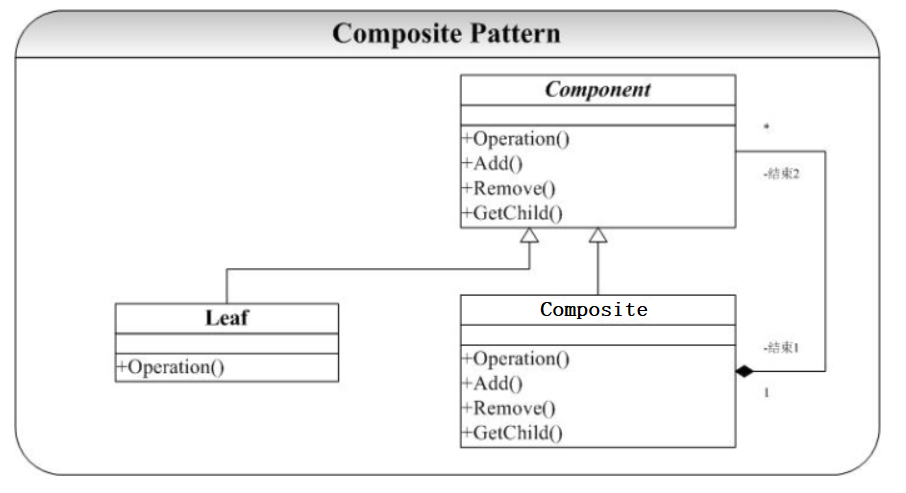结构型 - 组合(Composite)
组合模式(composite pattern): 允许你将对象组合成树形结构来表现"整体/部分"层次结构. 组合能让客户以一致的方式处理个别对象以及对象组合
[[toc]]
概念
Composite 模式典型的结构图为:

组件(Component)类是组合类(Composite)和叶子类(Leaf)的父类,可以把组合类看成是树的中间节点。 组合对象拥有一个或者多个组件对象,因此组合对象的操作可以委托给组件对象去处理,而组件对象可以是另一个组合对象或者叶子对象。
代码实现
#ifndef _COMPONENT_H_
#define _COMPONENT_H_
class Component
{
public:
Component();
virtual ~Component();
public:
virtual void Operation() = 0;
virtual void Add(const Component &);
virtual void Remove(const Component &);
virtual Component *GetChild(int);
protected:
private:
};
#endif //~_COMPONENT_H_
#include "Component.h"
Component::Component()
{
}
Component::~Component()
{
}
void Component::Add(const Component &com)
{
}
Component *Component::GetChild(int index)
{
return 0;
}
void Component::Remove(const Component &com)
{
}
#ifndef _COMPOSITE_H_
#define _COMPOSITE_H_
#include "Component.h"
#include <vector>
using namespace std;
class Composite : public Component
{
public:
Composite();
~Composite();
public:
void Operation();
void Add(Component *com);
void Remove(Component *com);
Component *GetChild(int index);
protected:
private:
vector<Component *> comVec;
};
#endif //~_COMPOSITE_H_
#include "Composite.h"
#include "Component.h"
#define NULL 0 // define NULL POINTOR
Composite::Composite()
{
// vector<Component*>::iterator itend =comVec.begin();
}
Composite::~Composite()
{
}
void Composite::Operation()
{
vector<Component *>::iterator comIter = comVec.begin();
for (; comIter != comVec.end(); comIter++)
{
(*comIter)->Operation();
}
}
void Composite::Add(Component *com)
{
comVec.push_back(com);
}
void Composite::Remove(Component *com)
{
//comVec.erase(&com);
for (std::vector<Component *>::iterator iter = comVec.begin(); iter != comVec.end(); )
{
if (*iter == com)
{
iter =comVec.erase(iter);
}
else
{
iter++;
}
}
}
Component *Composite::GetChild(int index)
{
return comVec[index];
}
#ifndef _LEAF_H_
#define _LEAF_H_
#include "Component.h"
class Leaf : public Component
{
public:
Leaf();
~Leaf();
void Operation();
protected:
private:
};
#endif //~_LEAF_H_
#include "Leaf.h"
#include <iostream>
using namespace std;
Leaf::Leaf()
{
}
Leaf::~Leaf()
{
}
void Leaf::Operation()
{
cout << "Leaf operation....." << endl;
}
#include "Component.h"
#include "Composite.h"
#include "Leaf.h"
#include <iostream>
using namespace std;
int main(int argc, char *argv[])
{
Leaf *l = new Leaf();
l->Operation();
Composite *com = new Composite();
com->Add(l);
com->Operation();
Component *ll = com->GetChild(0);
ll->Operation();
return 0;
}
[root@VM-16-6-centos Composite]# ./ComponentTest
Leaf operation.....
Leaf operation.....
Leaf operation.....
代码说明
Composite 模式在实现中有一个问题就是要提供对于子节点( Leaf)的管理策略,这里使用的是 STL 中的 vector,可以提供其他的实现方式,如数组、链表、 Hash 表等。
讨论
Composite 模式通过和 Decorator 模式有着类似的结构图, 但是 Composite 模式旨在构造类,而 Decorator 模式重在不生成子类即可给对象添加职责。 Decorator 模式重在修饰, 而Composite 模式重在表示。
